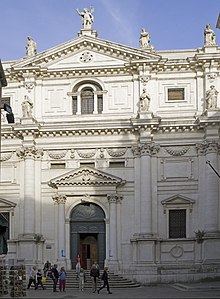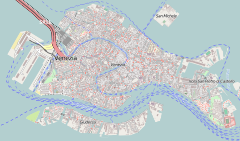| Church of San Salvador | |
|---|---|
 Face of San Salvador | |
| Religion | |
| Affiliation | Roman Catholic |
| Province | Venice |
| Location | |
| Location | Venice, Italy |
| Geographic coordinates | 45°26′12″N 12°20′11″E / 45.4366°N 12.3365°E |
| Architecture | |
| Architect(s) | Giuseppe Sardi(facade) |
| Type | Church |
| Style | Baroque, Renaissance |
| Completed | 1663 (facade) |
The Chiesa di San Salvatore (of the Holy Savior) is a church in Venice, northern Italy. Known in Venetian as San Salvador, is located on the Campo San Salvador, along the Merceria, the main shopping street of Venice. The church was first consecrated in 1177 by Pope Alexander III shortly after his reconciliation with Emperor Frederick Barbarossa at nearby San Marco. The present church, however, was begun in around 1508 by Giorgio Spavento and continued after his death the following year by Tullio Lombardo, Vincenzo Scamozzi and possibly Jacopo Sansovino. They built a large hall church, formed from three Greek crosses placed end to end. Each has a dome with a lantern to let light into the cavernous interior. The facade was added in 1663 by Giuseppe Sardi.
Adjoining the church is the former monastery, now the offices of the telephone company, which still contain Sansovino's magnificent cloisters.
San Salvador is the parish church of a parish in the Vicariate of San Marco-Castello. Other churches in the parish are San Bartolomeo and San Zulian.
San Salvador is a small, but still-active religious, cultural and social centre.[1]
Below the left column on the facade there is a cannonball embedded in the base of the column. It derived from a bombardment in 1849 by Austrian forces in the port of Marghera, of the independent republic which had been proclaimed by Daniele Manin.

-
Inside
-
Polychrome marble mosaic
-
Altarpiece and main altar
Historical Legend & Early History edit
The first iteration of San Salvador was known as one of the first of Venice's seven churches built on divine order. The assertion of this divine order was generated by the early myth of Venice and the city’s divine origins. The legend stated the first bishop of Venice, Saint Magnus, was willed by god to found the city. He constructed two churches before Christ, in 638 AD, directed Magnus to build San Salvador in his honor. There is a lack of documentation regarding the early history of the original church. However, the surviving information depicts a church reminiscent of the Holy Sepulcher, with an interior floor consisting of some metal grates viewing the running water below. More documentation arises post 1177 likely due to the increase of prestige gained after the Church’s consecration. In 1209 the Church saw its first rebuild; either due to a recent fire severely damaging the original, or due to the church’s elevated status. Accounts depict either a medieval cross planned basilica or a longitudinal plan. Sources indicate a possible mosaics with depictions primarily of Christ and also Doge Marino Morosini kneeling. This close connection to the Doge depicts the high status of San Salvador at the time. This status is further embellished In 1267, as the church was home to the relics of Saint Theodore; the first patron of the city. [2]
Works of art edit
- Jacopo Sansovino (tomb of Francesco Venier on the south wall).
- Titian (Annunciation on the south wall and Transfiguration, the altarpiece of the high altar).
- Francesco Vecellio (paintings on organ doors; frescoes in tomb in floor in front of high altar).
- Alessandro Vittoria (altar on north wall, with statues of St. Roch and St. Sebastian).
- Giulio Angolo del Moro Savior in Monument of Andrea Dolfin.
-
Francesco Venier's monument
-
Organ
-
Resurrection by Francesco Vecellio
-
Transfiguration by Francesco Vecellio
-
Savior by Giulio del Moro
Funerary monuments edit
- Caterina Cornaro (d.1510) (Queen of Cyprus).
- Andrea Dolfin
- Doge Gerolamo Priuli
- Doge Lorenzo Priuli
- Doge Francesco Venier (d.1556).
See also edit
External links edit
- ^ web site Archived 2010-03-13 at the Wayback Machine
- ^ "The Power of space: The high altar of the Venetian church of San Salvador - ProQuest". www.proquest.com. Retrieved 2023-11-07.




